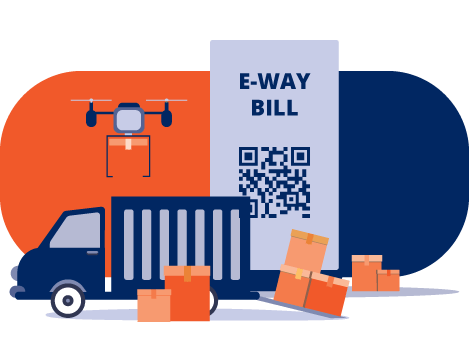An e-way bill is a document created online on the GST portal. As per the current GST rules, it must be generated when moving goods worth more than Rs. 50,000. This document acts as proof that goods are being transported legally.
Also, it helps in tracking the transportation of goods. This reduces tax evasion and supports NBFCs and banks which are usually involved in financing operations. Some of the major details covered in an e-way bill are the:
- Value of goods
- Vehicle used
- Parties involved
- Source and destination of goods
It is worth mentioning that the mere generation of an e-way bill is not sufficient to ensure compliance with GST rules. You must comply with its various requirements as well. In this article, let’s understand the structure of an e-way bill and see some of the major e-way bill requirements you must fulfil when transporting goods via road.
The structure of an e-way bill
An e-way bill is divided into two parts:
- Part A: This section collects key details about the goods and transaction, like:
- Goods and Services Tax Identification Number (GSTIN) of the buyer (recipient).
- Delivery location
- Invoice or challan details (number and date)
- HSN code for the goods
- Value of goods
- Transport document number (like Goods Receipt for road transport)
- Reason for transportation
- Part B: This section is for transport details and includes the vehicle number or transporter ID. It ensures that the transport route and vehicle are documented.
Be aware that once both the parts are filled, the e-way bill is generated. Now, based on this structure, several additional requirements must be fulfilled.
E-way bill requirements you must fulfil
Be aware that an e-way bill can be used for various purposes such as supplies made from online marketplaces or physical locations, sales returns, personal use, or job work. It has a pan-India validity. However, for a seamless movement of goods via road, you must also satisfy these additional e-way bill requirements:
- Vehicle and transporter details
The transporter must provide the vehicle number and transporter ID in Part B of the e-way bill. If a supplier uses their own or hired vehicle, they can fill in Part B themselves.
- Generating the e-way bill
The supplier provides the required details in Part A to the transporter. Based on these details, the transporter completes Part B to generate the e-way bill. Once it is generated, an e-way bill number (EBN) is issued.
- Short distance exceptions
Goods can be moved with only Part A if the distance is:
- Less than 50 km from the supplier’s location to the transporter’s location.
- Less than 50 km from the supplier to the recipient.
- Changing vehicles during transit
If the goods are moved to a different vehicle during transit, the transporter must update the vehicle details on the GST portal.
- The validity period of the e-way bill
The bill is valid for 1 day per 100 km. For every additional 100 km, an extra day is added. If the transport cannot be completed within the validity period, a new e-way bill can be generated with updated details.
- Multiple vehicles for transport
When using multiple vehicles, the supplier must issue the invoice with the first consignment. Also, copies of the invoice and delivery challans should be sent with subsequent consignments. Most importantly, the original invoice should accompany the final consignment.
Conclusion
From February 1st, 2018, it is mandatory to generate an e-way bill for both inter-state and intra-state supplies worth more than Rs. 50,000. This document is divided into two parts: Part A (goods and transaction details) and Part B (transportation details). You are legally required to fill in both these parts.
Additionally, you must adhere to several other e-way bill requirements, such as:
- Updating vehicle details during transit
- Following short-distance exceptions
- Managing validity periods
Moreover, when multiple vehicles are used, you need to maintain proper documentation with invoices and challans. By following these guidelines, you can avoid penalties and ensure the seamless movement of goods across India.









